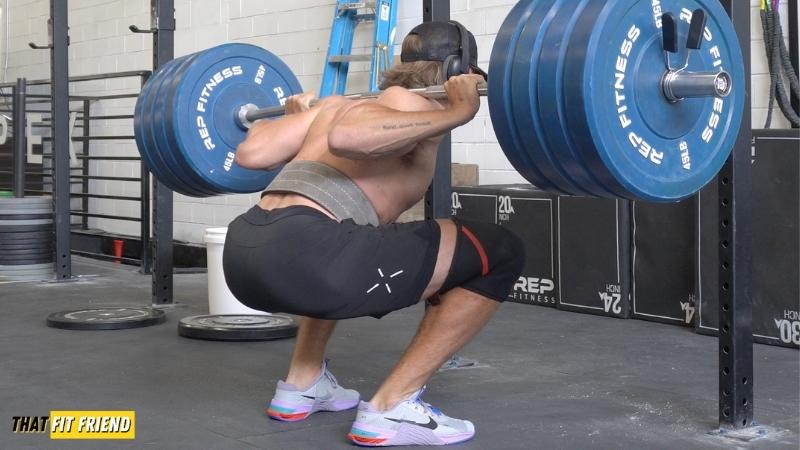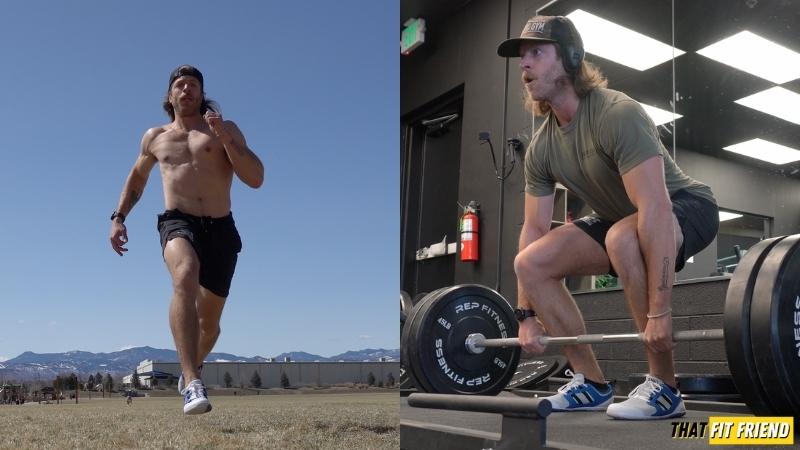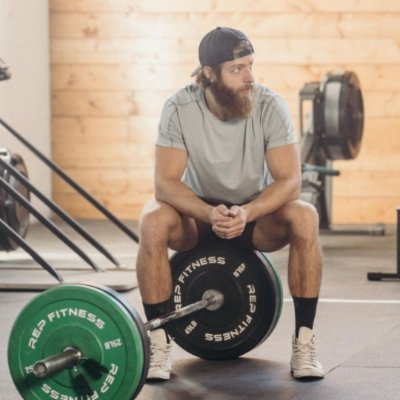In the world of running shoes, stack height is a common and important metric that runners will look to when assessing which running shoes to buy based on their running preferences and needs.
For cross-training shoes, it’s less common to spend time assessing and thinking about a shoe’s stack height.
Now, this doesn’t mean that stack height isn’t important for cross-training shoes and should be completely disregarded — because it can be important and I’ll discuss why below — more so that it means that it’s not at the top of the hierarchy of importance when looking into new cross-training shoes.
Table of Contents+
What Is Stack Height?
Stack height is the amount of material that separates the foot from the ground when there is no foot in the shoe. This includes accounting for the midsole, outsole, and all of the materials that are between the foot and the ground.
The reason we reference stack height without a foot in the shoe is due to the fact that someone’s weight will cause the midsole and materials of the shoe to compression which would then alter the shoe’s true stack height metric based on who’s standing in the shoe.
For example, everyone has different body weights and different means of shifting pressure in their feet, thus strengthening the reason why stack height isn’t recorded with a foot in the shoe.
How Is Stack Height Measured In Running Shoes?
For running shoes, there are typically two stack height measurements taken. The stack height of the heel, which is measured around the center of the heel, and the stack height of the forefoot, which is typically measured at the base of the forefoot.
These two numbers are then subtracted to get the shoe’s hee-to-toe-drop or offset. So, if we had a running shoe with a 26mm heel stack height, and a 16mm forefoot stack height, then we’d be left with a 10mm heel-to-toe drop or offset.
Zero drop running shoes, AKA running shoes with 0mm heel-to-toe drops, will only have one stack height measurement since the forefoot and heel have the same stack heights.
Running shoes will then be categorized into different groups per their stack heights. For example, it’s common to hear running shoes categorized in regard to their stack heights by terms like minimalist, maximalist, and regular.
These terms in addition to a shoe’s offset can then help runners bucket models into performance categories based on their running preferences and foot strike patterning.
How Is Stack Height Measured In Cross-Training Shoes?
In the context of cross-training shoes, it’s common to clearly define a shoe’s heel-to-toe drop, but the shoe’s stack height is rarely if ever referenced. My theory for this is due to the fact that stack height in training shoes and running shoes will mean entirely different things in regard to performance.
For example, when discussing and measuring stack height in cross-training shoes, we’re not necessarily worried about our foot strike patterning. Instead, we’re worried about how a shoe’s stack height will impact stability, versatility, and biomechanics for certain exercises.
That being said, stack height in cross-training shoes can technically be measured in a similar manner to how we measure stack height in running shoes. However, I think it can be a bit more productive to instead look at the cross-training shoe’s average stack height, then create categories from there.
When reviewing cross-training shoes, I have three different buckets that I’ll put a shoe’s stack height in. These buckets, which are somewhat similar to how other bucket running shoes, reflect the average stack height of certain cross-training shoes.
- Minimalist, More Ground Feedback: These are shoes like barefoot shoes and cross-training shoes with thinner and more maneuverable midsoles that are built to give you more ground feedback and stability.
- Normal, Blend of Ground, and Shoe Feedback: These are training shoes with standard midsole constructions that provide some ground feedback and offer a normal level of cushion with a blend of stability and versatility.
- Thicker, More Cushion, and Shoe Feedback: These are training with thicker midsoles that are designed to give you more “bounce” and cushion when training, and will generally lean more towards versatility.
Check out the visual below that highlights examples of how I assess and bucket certain cross-training shoes in regard to their stack height influencing stability and versatility.

Essentially, I like to think about a cross-training shoe’s stack height as being on a spectrum of stability and versatility. Generally, if we have less stack height, stability will go up, and if we have higher stack heights, then stability will go down and versatility will go up.
Then what I’ll do is take where that shoe lands and cross-reference the activities in which athletes and lifters will typically use that shoe. This can then help suggest which models to go with based on one’s individual training preferences, wants, and needs.
For example, let’s say you’re looking for a shoe that will excel for CrossFit. In this context, you’ll want a shoe that provides a nice blend of stability and versatility, so you’ll want to look at shoes that land in the “normal” stack height range. If you wanted more stability and plan to lift really heavy, then you’d look into a minimalist or normal shoe.
Since stack height will mean different things for activities like running and CrossFit, I think how we assess and conceptualize stack height in these types of shoes should be different than how it’s assessed and measured in running shoes.
Is Stack Height Important for Cross-Training Shoes?
Stack height is important to an extent in cross-training shoes. I like to think about stack height in cross-training as existing on a spectrum of importance based on how you plan to use your shoes.
Typically, the more niche and serious you go with your training, the more you’ll want to be specific with the type of stack height and shoes that you look into. This is similar to running as well as you get more serious with your training and running.
For example, if your goal is barbell training and you plan to train heavy often, then you’ll want a shoe that has a minimalist or normal stack height to prevent potential stability issues from thicker or more grandiose stack heights that can easily compress under different weights.
That being said, a stack height’s importance in cross-training is fluid and should be scaled based on your training needs. I like to compare it to running shoes for marathons.
Running shoes and their importance for a marathoner will be different than a recreational runner only tackling a few miles a week. Similarly, cross-training shoes for serious CrossFit workouts will differ in importance from a beginner lifter’s shoe choice who’s just starting out.
Note, at the end of the day, stack height can also be based on preference and what feels best for you. The goal is to blend what you prefer with what will contextually work best.
Pros and Cons of Thicker Stack Heights In Cross-Training Shoes
A thicker stack height will give you a greater “shoe feel” when training, as in you’ll have more cushion and a bit less ground feedback than a lower stack height shoe.
Pros
Thicker stack heights can be useful for training sessions that involve a bit more running, jumping, and HIIT-style training. These activities can all increase ground reaction force which can add up and take a toll on the body in regard to one’s body’s durability when tackling strenuous sessions.
A higher stack height with a bit more cushion in training shoes can help displace some of the force that you’ll take in high-intensity sessions.
This can be useful for heavier athletes and those that prefer to have a bit more cushion when training. Additionally, thicker stack heights can be useful for those that are not acclimated to lower stack heights and more stable cross-training shoes.
Cons
While thicker stack heights can be useful in certain training contexts, they can fall short for activities like lifting and CrossFit. Think back to our stack height continuum. More stack height generally leads to less overall stability.
A good example of this would be lifting in running shoes with high stack heights. Can you do it? Sure, but it’s going to be sub-optimal for the task at hand.
Pros and Cons of Minimalist and Normal Stack Heights
Minimalist and normal stack heights in cross-training shoes will give you more ground feel and a blend of shoe and ground feel, respectively.
This means that when you’re training, you’ll feel the ground to a greater degree and there are multiple pros and cons that come along with these stack heights.
Pros
Minimalist and normal stack heights in cross-training shoes will typically be better picks for activities like lifting, CrossFit, and athletic-focused sessions. Generally, these types of training will involve heavier lifting and explosive movements and it can be beneficial having more “ground feel” in these training contexts.
Minimal stack heights will give you the most stability and ground feedback, while normal stack heights offer a blend of ground and shoe feel. Normal stack heights typically align really well for anyone that likes to vary their training on a weekly basis.
Cons
In regard to cons, there aren’t too many cons that come along with cross-training shoes that have normal stack heights. Other than niche scenarios like longer runs, generally, this type of stack height will perform well in most contexts.
The main drawback to minimalist stack heights is the fact that you’ll likely need to have an acclimation period with them. Since you’re getting a lot more ground feedback with this style of stack height your feet will need to adjust to the increase in force that your feet are experiencing while training.
Plus, training and the demands it can place on the body can vary greatly depending on your training session. This is similar to the idea of slowly acclimating to barefoot shoes versus jumping in and using them for everything.
Frequently Asked Questions (FAQ)
Q:What is a shoe's stack height?
Q:How is stack height measured?
Q:Why is stack height important?
Stack Height Takeaway Points
A cross-training shoe’s stack height will vary in importance based on how you plan to use and train in your shoes. As you get more specific with your training, your shoe and gear choice should reflect the specificity of your training needs.
Below are some of my suggestions for cross-training shoes in certain contexts. In my reviews on That Fit Friend, I naturally address this topic by referencing stability, versatility, and which contexts certain shoes will work best for.
- Plan to Train Heavy: Look into cross-training shoes with minimalist or normal stack heights. Go normal if you vary your training frequently.
- Plan to Do CrossFit: Look into cross-training shoes with normal stack heights.
- Plan to Do HIIT, Classes, Cardio: Look into cross-training shoes with normal and thicker stack heights.

















Anthony
Something that should be addressed is how compressible it is. If you only use the stack height, it’s almost useless because often a weightlifting shoe *will* have a high stack, but so will a running shoe, but lifting shoe has less compressibility. Gives you a less butt wink, open hips, etc. I find it hard to compare lifting vs running shows and stack heights to the point of it being useless to do without compressibility discussion
Compression is definitely significant to consider along with how dense midsole/outsole materials are. I’m going to add a section discussing a few common materials used in training shoe midsoles which are often featured in different stack heights — I love the suggestion and I shouldn’t assume folks understand that aspect, thank you for the add!
In the context of weightlifting shoes, the forefoot/heel’s stack should always be assumed to be dense/firm, IMO, and the drop is more important to consider in most contexts. Also, I didn’t intend to reference weightlifting shoes in this article, primarily cross-training shoes and then running shoes to provide contrasting examples! 🙂